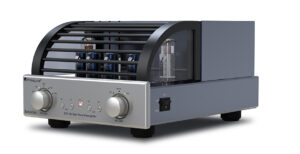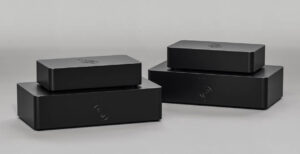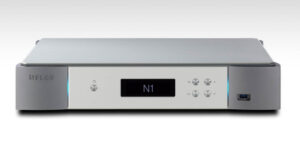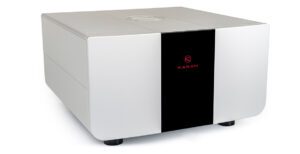
Hi-fi keeps getting better, but even the best falls foul of a fundamental limitation – the room. Our rectangular living spaces can mess up the sound of many a wonderful system; bass booms and reflections from the walls, floor and ceiling all undermine the performance.
We can help reduce these problems using either DSP or room acoustic treatments. Both can transform an audio system, but come with ‘baggage’. DSP systems vary; some great, some not so great, and a lot comes down to installation. Room treatments can also work wonders, but in a small room, they can be intrusive; it’s bad enough to have a floor full of audio gear, ice forms on the long-haired general’s upper slopes when your hobby takes up the walls and corners too.
A more consistent and domestically chummy arrangement would be to design a product that overcomes many of the intrinsic problems with using a loudspeaker in a room. And that’s where the Gradient Helsinki 1.5 comes in. That distinctive shape isn’t only for decoration; it’s designed to make the speaker room ‘independent’ (the reality is ‘less dependent’ rather than truly ‘independent’… but that’s enough to make a big difference).
It may look like a designer chair for a hobbit, but the Finnish Helsinki 1.5 is actually an open-baffle design, made with sustainable woods and a large clear glass spine and base, using conventional ‘cone and dome’ drive units. Each drive unit has its own unique construction methodology; the tweeter sits in a moulded polyurethane wave-guide ‘donut’, the midrange unit sits in a cardioid baffle (it’s another rounded, 7cm thick recessed moulded polyurethane pod filled with absorbent material) and the bass driver is sitting effectively an open baffle, at 90° to the listener.
That means the listener sits on the null point of the bass driver’s dipole’s radiation pattern. In theory, that makes it the worst placement possible, but that’s kind of the point of what Gradient calls ‘controlled directivity’. The trick is instead of trying to eliminate the first reflection from side walls for the bass, the Helsinki 1.5 makes a feature of it, while effectively eliminating the first reflection from above and below. In many rooms, you have the magnets pointing toward one another (so the bass cones pointing outward) and give the speakers a sharp toe-in; the bass effectively relies on those side walls. How sharp a toe-in? Think 45°, which puts you sitting in the near field. In very small rooms, the speakers are swapped over so the bass units fire at each other, with the speakers pointing directly down the room; this cuts down a lot of bass, but not enough bass is rarely a problem in a small room.
Frequencies above 200Hz are handled very differently. The placement (particularly the angles) of the midrange and treble drivers are designed specifically to minimise first reflection issues. The tweeter is a perfect example of this; the back-swept pod is not just time alignment and styling, it means the first reflection point on the ceiling is actually behind the listener. That makes a huge difference to the sound. There’s also the incredibly tight tolerance in the speakers meaning the pair matching is excellent and the speaker is flat to within a decibel from 200Hz-20kHz. That’s almost unheard of in domestic speaker designs.
This combination would make measurement on and off axis very difficult to get right. You have a treble and midrange that will deliver incredibly accurate on and off-axis performance, coupled to a bass that only really works off axis.
The review pair of speakers were supplied with a set of DNM speaker cables, in part because the Helsinkis are internally wired with DNM and in part because the speakers use the pro-grade Speakon terminal and DNM was first to step up to the task.
The big question is whether the Helsinki 1.5 achieves the goal it sets, eliminating (or at least substantially reducing) the effects of the room on the speakers. The answer – for frequencies of 200Hz and above is a resounding ‘yes’. There’s none of the blurring and blooming of random frequencies bounced off the side walls and ceiling. Instead, the Gradient design seems to give you all the precision and dynamic range of a good dynamic speaker with all the directness of a good pair of headphones… in the free field.
The Helsinki is almost perfectly designed for ‘problem’ rooms. Beastly concessions to architecture unwilling to make compromises for audio are effectively dialled out of the sound. Furniture in inopportune places, alcoves, fireplaces, TV sets, coffee tables, marauding wives patrolling the room… none of these things make the slightest difference. As a consequence, speaker position both is and isn’t critical; the need for the loudspeakers to be equidistant from the rear and side walls is minimised, although your position relative to the loudspeakers is completely vital if the bass is to give of its best. You can experiment with toe-in up to a point – a less powerful toe-in gives a more uniform sound for more listeners, but the tonal balance changes slightly, as if using a tilt control from an old Quad preamp – either treble down and bass up or bass down and treble up. Ultimately, there’s a sweet spot for the room, and the user.
Its sound is both astonishing and a little bit disturbing for many listeners. Unless you’ve spent a great deal of time in well-engineered studios or listening rooms that have been very carefully corrected (with mechanical methods, rather than DSP), you’ll be used to hearing your loudspeakers, plus the singalong from the walls and ceilings. Simply removing that singalong is like injecting sound direct into the ears. Soundstaging opens out, instruments have their natural tone and ambient information is portrayed with uncanny accuracy.
That’s astonishing because so much ‘disappearance’ of loudspeaker box is usually a function of panel designs, but the Helsinki is more dynamic than any panel. But, short of a few dipole designs (Jamo, Lyngdorf, Linkwitz kits), you won’t find a set of dynamic drivers without some (even residual) box coloration. The absence of box coloration is disturbing because we’re used to it.
The result is a remarkably accurate sound, most unlike the sort of ‘hi-fi’ reproduction we have come to expect from most audio equipment. In particular, the presentation of stereo is beyond reproach. Your recordings are replayed with precisely the same stereo information they had in the control room. Large, ambient recordings are just that, close mic’d recordings are pushed in front of you and anything in between is, well, somewhere in between. This is the ‘disturbing’ part; when you remove the room and the speaker from the equation, you need to spend some time getting used to the sound.
You might also need time to adjust to box speakers afterward. This is the clincher whether the Gradient Helsinki 1.5 is for you or not. Spend a few hours (ideally a longer term) in front of them and then go back to your box loudspeakers. If the immediate reaction is “isn’t this artificial sounding?”, Helsinki has got its hooks in you.
The big downside is the bottom end. Or rather, the lack of it; there’s not a lot of energy below 50Hz. In musical terms, this is equivalent to the last couple of notes of the ‘first octave’ (40-80Hz), and all of the bottom octave (rumbles, thunder rolls and deep organ pipes). In perception terms, this underpins the sound and gives music its force. The roll-off is smooth and clean enough to allow for a subwoofer to fill in the blanks at the bottom end of things. Those who see the charms of the loudspeaker for what it is will see no problems in moving to 2.1 channels. In addition, as the speaker was designed for rooms up to about 400 sq ft and to be use a foot or so from the wall, a sub might not be necessary (because the loudspeaker behaves so different from the norm, we’ve broken with Hi-Fi+ tradition and included comments by Tim Ryan of SimpliFi Audio on this important design).
Eagle-eyed readers might notice an almost complete absence of references to pieces of music in this review. This is because pieces of music are generally used to highlight good points and bad in a component. That’s not relevant here because the Helsinki 1.5’s sound is relevant to all music. If you like how it sounds, you like how it sounds on all music.
The Gradient Helsinki 1.5 is a remarkable and successful way of virtually removing the loudspeaker box and the room from the sound. This makes it ideal for those who have decided to call time on box coloration but can’t use or bring themselves to learn to love panels. While some will demand more bottom end, this still doesn’t stop recommending what is one of the most exciting and realistic-sounding loudspeakers money can buy.
______
SIDEBAR: The Helsinki Speaker Topology
The speaker was designed for rooms around 300-400 sq ft (30-44sq metres) and to be within a foot or so of either the front or side walls. This set-up typically gives adequate bass without a sub-woofer; if the speaker is far from the room boundaries then a subwoofer becomes more beneficial.
One can consider the speaker as divided in two parts; the bass below 250Hz is handled by a open-baffle 300mm driver, which has the classic ‘figure-of-eight’ radiation pattern, while the midrange and HF have cardioid (heart shaped) radiation patterns, with almost no energy going behind the drivers/toward the back wall.
The first thing to note about this topology is the lack of the typical speaker cabinet/ported box colorations as there is no box! The second observation is how the midrange and tweeter drivers are
tilted up. This dials out the first reflection point from the floor. In addition, the upward drivers provide excellent imaging whether the listener is sitting or standing.
______
SIDEBAR: In-Room Bass
Similar to organ pipes, a room 28ft long produces a resonance/room mode at 20Hz, a room width of 14ft produces a mode at 40hz and a room 7ft high produces a mode at 80Hz, The most audible of these room modes is the one due to shortest room dimension (typically the room height) and has harmonics at twice and three times the fundamental frequency (in our example at 160 and 240Hz, which is right up in the lower bass/midrange).
A characteristic of dipole bass is the ‘figure-of-eight’ radiation pattern. If one puts a microphone on-axis with the bass driver you will measure maximum bass. However at 90° to the driver you will measure a null. Likewise directly above the speaker you will also have a null – the speaker is not sending bass to the ceiling and therefore exciting the most audibly damaging room height mode.
With the speaker perpendicular to the front wall, the in-room bass is primarily a function of the room width. Rotating the speaker through 45 degrees excites both the room width and length modes. In this way, rotating the speaker is like using a tone control; minimum bass is achieved with the speaker perpendicular to the front wall, maximum at 45 degrees.
On the other hand, a dome tweeter and cone midrange have different geometries and hence very different dispersion patterns. As the Helsinki is designed to give both drivers the same cardioid radiation pattern, one can think of them as headlights of a car with strong output +/- 30° and very little energy outside this area. As such, the speaker is sending very little energy to adjacent surfaces such as the side walls.
The Helsinki has a flat on-axis response of +/- 1 db from 200Hz-20kHz, so if you want to hear precisely what was laid down in the mastering session one should listen on axis. However, as one goes off axis, the extreme HF diminishes and gives a softer presentation.
SPECS & PRICING
Gradient Helsinki 1.5 Three-way loudspeaker
Tweeter: 19mm SEAS aluminium dome in wave-guide housing
Midrange: 125mm paper cone in cardioid housing
Bass: 300mm paper cone on side-firing open baffle
Impedance: Nominal 6 ohms (minimum above 4 ohms )
Sensitivity: 85 dB/2.83V / 1 meter
Connections: Speakon connector, bi-wirable
Amplifier recommendation: 50-250W
Dimensions (WxHxD): 35×92x50cm
Weight: 23kg
Speaker body available in Birch, oiled walnut, oiled oak and Matt black and white
Midrange and HF modules are available in matt black and white (special finishes on request)
Price: £4,500 per pair
Manufacturer:
GRADIENT
URL: www.gradient.fi
Distributor:
SIMPLIFI AUDIO
Tel: + (001) 724 712 0899
URL: www.simplifiaudio.com
By Alan Sircom
More articles from this authorRead Next From Review
See all
PrimaLuna EVO 100 phono preamplifier
- Apr 22, 2024

Reiki Audio SuperSwitch Master Pro + Servant Pro
- Mar 27, 2024

Melco Audio N1-S38 music server
- Mar 27, 2024











